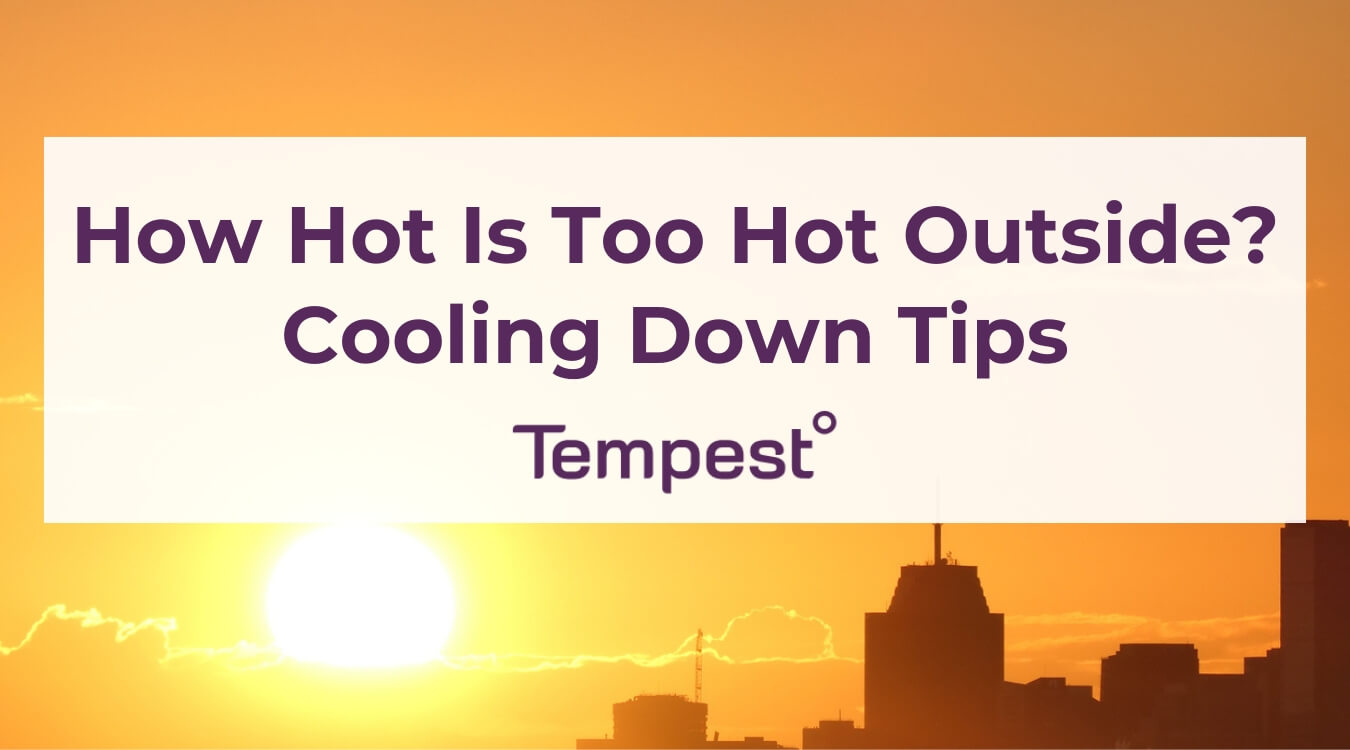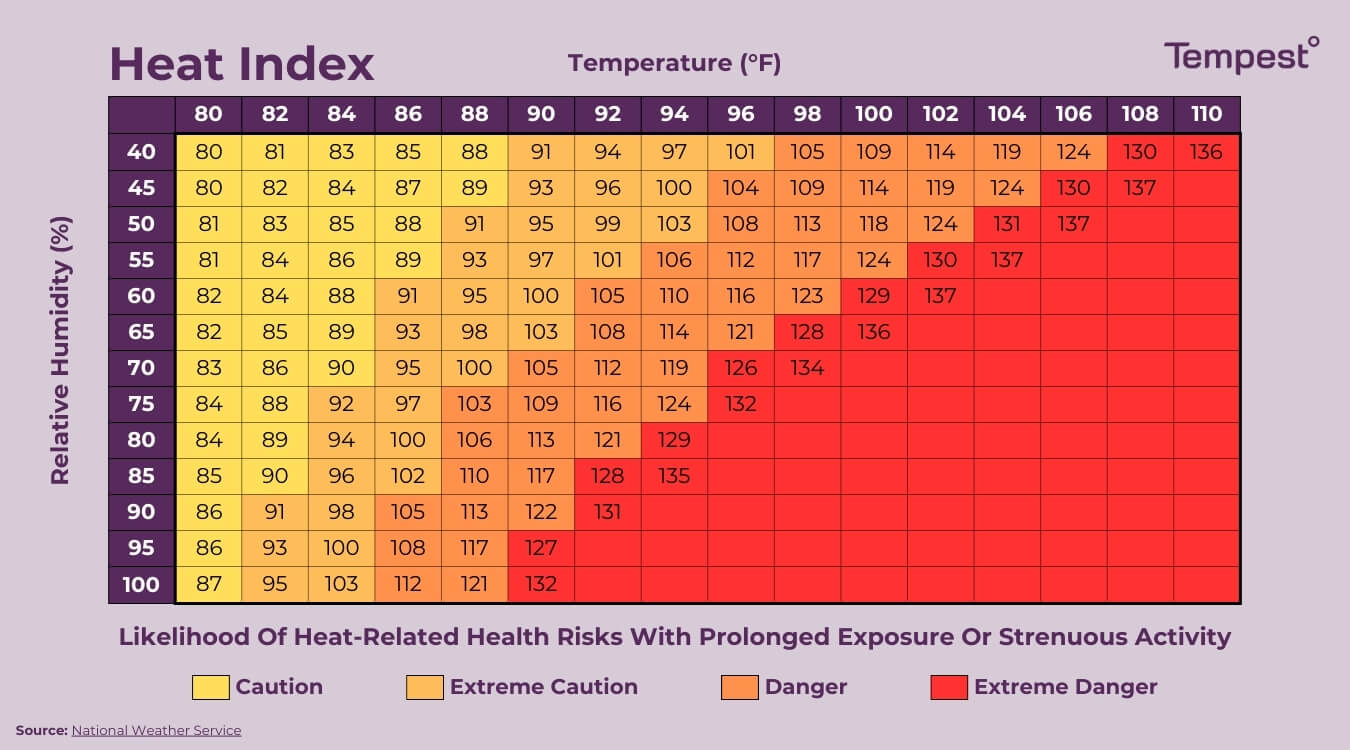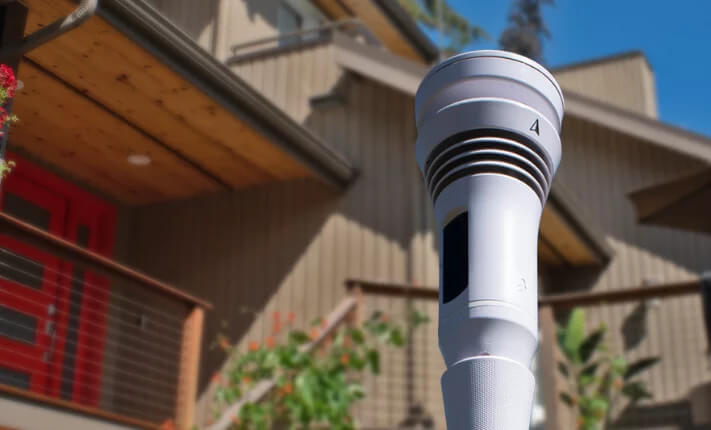
Maybe you’re someone who enjoys the heat, but when is it too hot to go outside? At certain temperatures, it’s not only uncomfortable to be outdoors but dangerous for the human body.
With extreme heat and severe heat waves becoming more common, it’s critical to know what temperature is dangerous for humans, and when you’re better off staying indoors on hot days. Below, we’ll discuss at what temperature is it unsafe to be outside and how you can keep cool to prevent heat-related illness.
- What Is The Heat Index?
- What Temperatures Are Unsafe For Humans?
- At What Temperature Is It Dangerous To Be Outside?
- How To Cool Down When It’s Too Hot Outside
Use the Tempest Home Weather System for local heat alerts and reliable real-time weather data, like the outdoor air temperature and heat index for your home’s location.
What Is The Heat Index?
The heat index is a measure that combines air temperature and humidity to reflect what the outdoor conditions actually feel like to the human body. For this reason, it may also be referred to as the feels like temperature.
The heat index provides a more accurate representation of discomfort and heat-related health risks than temperature alone. This is because it also considers humidity, which directly impacts the body’s ability to regulate temperature through perspiration in hot weather. Thus, the heat index helps to distinguish between dry and humid heat, which is important given how they affect the body differently.
Using the National Weather Service heat index chart, we can see that when it’s 88°F with 75% relative humidity, it feels more like 103°F, which puts you in danger of heat disorder from prolonged exposure or strenuous activity.
What Temperatures Are Unsafe For Humans?
An important weather fact is that above 90°F, humans are at a greater risk of heat illness from prolonged heat exposure, according to Yale Medicine emergency medicine specialist Dr. David Della-Giustina, MD. At these high temperatures, it’s easier to become dehydrated as the body attempts to cool down through sweating, which may lead to mild heat illness like heat rash and cramps, or worse, as the Cleveland Clinic explains.
These temperatures can be even more unsafe in areas with higher humidity. In these conditions, it’s not as easy for sweat to evaporate from your skin and cool the body, leading to more severe forms of heat illness like heat exhaustion or heat stroke, which can be fatal.
At What Temperature Is It Dangerous To Be Outside?
So, what temperature is too hot to be outside? According to researchers quoted in the MIT Technology Review, a wet bulb temperature of 95°F is the absolute limit for the human body. In dry conditions, this occurs when temperatures top 130°F. But with 50% relative humidity, this happens at a lower temperature, around 109°F.
At this point, the body can no longer effectively cool off by sweating. Under these conditions, even healthy individuals could be at risk of severe heat illness, organ failure, and death with prolonged exposure. Thus, it’s important to stay alert to local heat advisories and know when a warm front is moving in so you can take preventive measures to stay safe during extreme heat.
How To Cool Down When It’s Too Hot Outside
The Centers for Disease Control and Prevention (CDC) offers some tips on how to stay cool and prevent heat-related illness, including:
- Wearing loose-fitting clothing in lightweight, breathable fabrics
- Staying indoors in an air-conditioned area
- Drinking water to stay hydrated (about 4 cups per hour while working in heat)
- Taking a cool shower or bath to lower your body temperature
- Limiting outdoor physical activities, especially during peak sunlight hours
During extreme heat, watch out for these signs of severe heat illness, and seek out medical attention right away if you notice a loved one, especially an older adult, is experiencing these symptoms:
- Body temperature of 104°F or higher
- Hot, red, dry, or damp skin
- Fast and strong pulse
- Confusion or disorientation
- Nausea and vomiting
- Loss of consciousness
Understand Your Local Temperature Better With The Tempest Weather System
If you’ve ever wondered how long can you stay outside in 100-degree weather, understand that it’s best to limit your exposure to temperatures over 90°F and take the necessary precautions to avoid heat stress and illness. Remember that the risks only increase as humidity rises, as illustrated by the heat index.
And, if you want a better way to monitor your area’s heat index and outdoor temperature rather than relying on the spotty accuracy of local weather forecasts, consider installing an at-home weather station like the Tempest Home Weather System.
Shop the Tempest Home Weather System today for a guaranteed better forecast to drive all your weather-related decisions and beat the heat.


